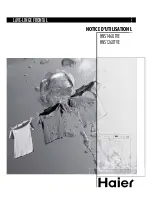
NOTE: Water pressure under 20 pounds per square
inch [138 kPa] will cause an extended fill time in the
washer.
Turn on the water supply faucets and flush the lines for approxi-
mately two minutes to remove any foreign materials that could
clog the screens in the water mixing valve. This is especially im-
portant when installing your washer in a newly constructed or
renovated building. Build-up may have occurred during construc-
tion.
Connecting Hoses
1.
Remove the two plain rubber washers and two filter screens
from the accessories bag.
2.
Install them into each end of the fill hoses as shown in
Figure
4
. The screen must be facing outward.
3.
Screw hose couplings with the filter screens onto the water
faucets until they are finger-tight. Use the red color-coded
hose for the hot water connection and the blue color-coded
hose for the cold water connection.
4.
Then, using a pliers, screw approximately 1/4 turn.
5.
Screw hose couplings from other end of hoses onto the water
mixing valve until they are finger-tight. Make sure the red
color-coded hose from the hot water faucet goes to the water
mixing valve marked “H” and the blue color-coded hose from
the cold faucet goes to the valve marked “C”. Refer to Figure
Figure 4
.
6.
Then, using a pliers, screw approximately 1/4 turn.
IMPORTANT: DO NOT cross thread or overtighten
couplings. This will cause them to leak.
7.
Turn water on and check for leaks.
8.
If leaks are found, turn off the water, unscrew hoses and rein-
stall them until there are no leaks.
IMPORTANT: Turn off water supply whenever there
will be an extended period of non-use.
TLW1988N_SVG
HOT
COLD
8
7
6
5
4
3
2
1
1.
Filter Screen (Screen must be facing outward)
2.
Fill Hose
3.
Rubber Washer (Plain)
4.
Cold Water Connection
5.
Hot Water Connection
6.
Install this end of hose to valve connections at rear of
washer.
7.
Install this end of hose to water supply faucet.
8.
Faucet
Figure 4
IMPORTANT:
Hoses and other natural rubber parts deteriorate after extended
use. Hoses may develop cracks, blisters or material wear from the
temperature and constant high pressure they are subjected to.
All hoses should be checked on a monthly basis for any visible
signs of deterioration. Any hose showing the signs of deteriora-
tion listed above should be replaced immediately. All hoses
should be replaced every five years.
Connect Drain Hose to Drain Recepta-
cle
1.
Remove the drain hose from its shipping position on the rear
of the washer by unhooking the hose from the retainer clamp.
2.
Install the drain hose into the drain receptacle (standpipe, wall
or laundry tub) following the instructions below.
NOTE: Drain receptacle must be capable of handling
a minimum of 1-1/4 inch [32 cm] outside diameter
drain hose.
Standpipe Installation
1.
Check standpipe height. The recommended height for the
standpipe is 36 inches [914 mm]. Standpipes higher than 4
feet [1220 mm] are not recommended.
2.
Place the adapter into the standpipe.
IMPORTANT: To prevent siphoning, do not place
any ribbed portion of the drain hose into the stand-
pipe.
3.
Remove the beaded strap from accessories bag and place
around standpipe and drain hose, approximately 12 inches
[300 mm] down from the top of pipe. Refer to
Figure 5
.
Installation
Part No. 202955R1
©
Copyright, Alliance Laundry Systems LLC - DO NOT COPY or TRANSMIT
7
Summary of Contents for AWNE92SP
Page 2: ......






























